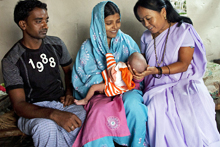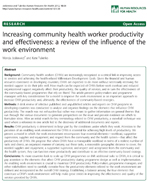
New Publication Spotlight: Increasing Community Health Worker Productivity and Effectiveness
Community health workers worldwide are taking on more and more responsibilities. They typically provide services such as educating community members on family planning and HIV prevention, counseling pregnant women, managing uncomplicated childhood illnesses, and supporting HIV/AIDS, malaria, and tuberculosis treatment programs. As their assignments pile up and their role in local health care grows, more and more people depend on their productivity and efficiency. But how many tasks can community health workers reasonably shoulder? How should their tasks be organized to maximize efficiency? And how many households can they be expected to be responsible for? There’s a lot of debate around those questions. One thing, though, is clear: when the workload becomes unwieldy, a worker’s productivity and work quality often suffer.
But how many tasks can community health workers reasonably shoulder? How should their tasks be organized to maximize efficiency? And how many households can they be expected to be responsible for? There’s a lot of debate around those questions. One thing, though, is clear: when the workload becomes unwieldy, a worker’s productivity and work quality often suffer.
A new article by CapacityPlus’s Wanda Jaskiewicz and Kate Tulenko in the journal Human Resources for Health highlights factors in the work environment that affect a community health worker’s performance and, ultimately, determine the effectiveness of community-based strategies. In the article, Increasing Community Health Worker Productivity and Effectiveness: A Review of the Influence of the Work Environment, Jaskiewicz and Tulenko present findings from a desk review of articles and reports on the subject. Workers need regularly replenished supplies, medicines, and equipment in order to carry out their tasks effectively—and to keep the trust and respect of their communities. They also need support from the formal health system. High-quality supervision, often one of the weakest links in community health worker programs, is vital. Without it, morale and productivity drop.
In the article, Increasing Community Health Worker Productivity and Effectiveness: A Review of the Influence of the Work Environment, Jaskiewicz and Tulenko present findings from a desk review of articles and reports on the subject. Workers need regularly replenished supplies, medicines, and equipment in order to carry out their tasks effectively—and to keep the trust and respect of their communities. They also need support from the formal health system. High-quality supervision, often one of the weakest links in community health worker programs, is vital. Without it, morale and productivity drop.
Among the authors’ recommendations for creating work environments that lead to productivity and effectiveness are the following:
- Conduct operations research to determine the highest number of tasks workers can undertake while still working effectively.
- Involve the workers in decisions about whether to add new services. Find out from them which services are most in demand and would be most valuable in their communities.
- Conduct time-use studies to understand how community health workers use their time to carry out their assigned duties, as well as any obstacles they encounter.
- Consider mobile technology as a way to help workers be more connected and communicative. Mobile phones can also give workers access to further training and help them order supplies and refer patients more efficiently.
- Strengthen the human resources management system to create working conditions that foster good performance.
To learn more, read the full article. And please let us know what you think; we welcome your feedback.
Related Items:
Photo by Trevor Snapp. (Community health worker with clients in India)


